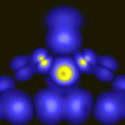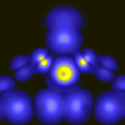Tuning conductance
Electron transport through molecules has implications for a range of subjects. In particular, conductance through single-molecule junctions is known to have a complex dependence on atomic structure, orientation, and bonding properties. However, investigations with atomic-scale control of the junction geometry are scarce.
In their paper in Physical Review Letters, Yongfeng Wang and collaborators from Germany, Denmark, and Sweden demonstrate that the conductance in a single-molecule junction varies over orders of magnitude.
Wang et al. present scanning tunneling microscopy measurements of the conductance of tin-phthalocyanine ( ) adsorbed on a surface in contact with a tungsten tip covered with silver. By manipulating the chemical bonding between and through selective dehydrogenation of and an atomic-scale structuring of the electrode, the conductance of single-molecule junctions is varied from to in units of the quantum of conductance. The authors also perform ab initio calculations combined with a nonequilibrium Green’s function technique for a quantitative analysis of the electron transport through junctions. This opens an avenue to study current flow through single molecules by combining transport measurements with atomic manipulation capabilities of the scanning tunneling microscope. – Sarma Kancharla





